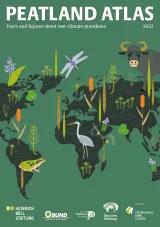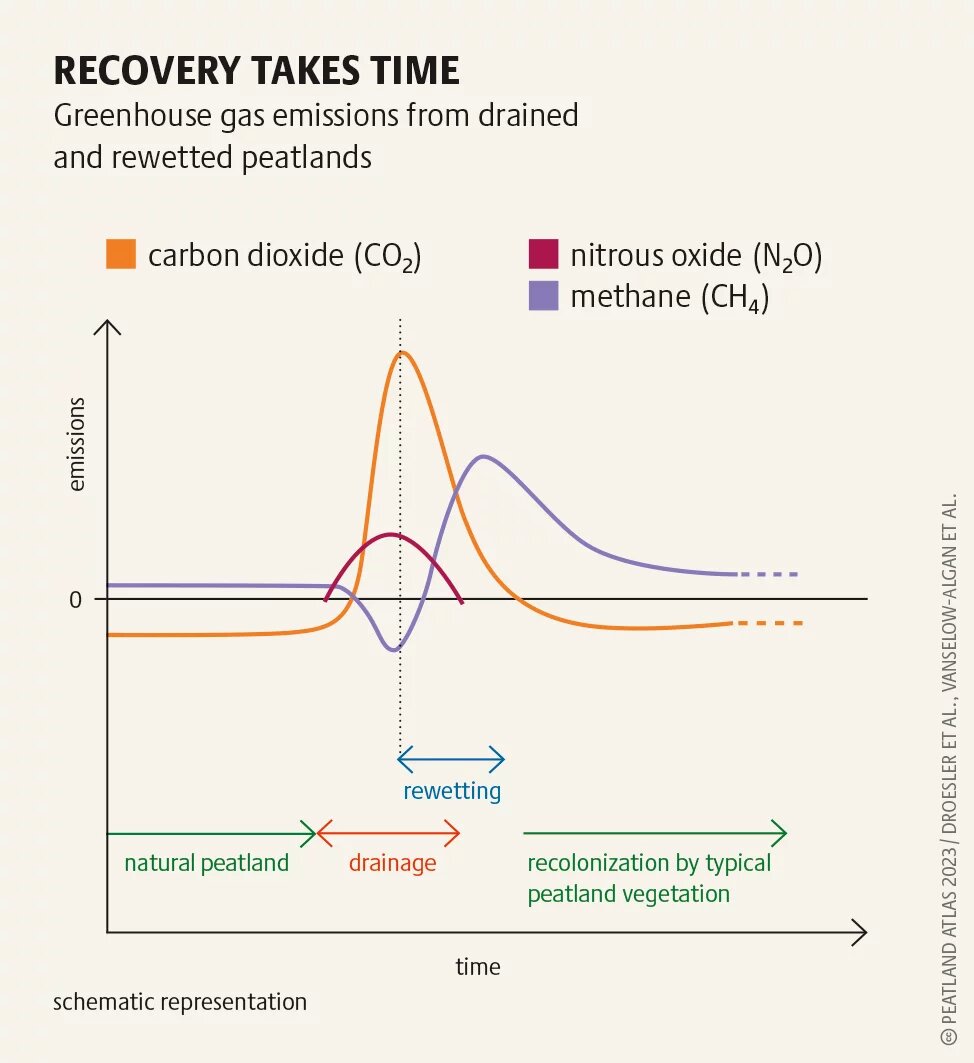
Drainage pipes and ditches are still being used to drain peatlands. Rewetting is urgently needed to protect both the climate and biodiversity. But how does this work – and what do we have to consider?

To protect the climate, a peatland should have a water table that is close to the surface of the soil. The majority of intact or rewetted peatlands do not look like a lake, but rather are swampy areas with scattered pools of water. They may have open vegetation or be thickly forested. Because every peatland is different, the rewetting process must be planned for each one individually. Waterflow must be identified, the height differences of the land surveyed, and drillings made in the soil. The soil samples reveal the thickness of the organic layer and the characteristics of the peat – whether it is very permeable or highly decomposed and impervious to water. This information forms the basis for a plan on how to retain water in this particular peatland, and what optimal water level should be aimed at. The rewetting of larger, hydrologically connected areas is usually practical and less demanding. After the conversion works are completed, comprehensive monitoring will be needed to check how the water levels and the habitat for peatland-typical species develop.
For all peatland types, the first step is to bring water back into the peat. In general that means turning off the pumps, pulling the drainage pipes out of the ground, and blocking up the ditches. Special excavators are used to do this. They ride on extra-wide caterpillar tracks so they do not sink into the soft ground.
The subsequent process of rewetting depends on the type of peatland. If it is rain fed, as in raised bogs, dams are often built to prevent the water from running off to the sides. To build these, suitable peat is heaped and compacted by driving over it with excavator tracks to reduce the flow of water underneath the dam. In some peatlands, it may make more sense to insert a solvent-free pond liner vertically into the ground, creating a kind of enormous bathtub that will fill up with rainwater. The previously dried-out peat will then soak up the water and swell. Adjustable overflows make it possible to set the water level at the optimal height for peat forming. In fens, which are fed mainly by various groundwater and surface water flows, it is necessary to take wider areas into consideration during rewetting. A stream that flows through the depression can be used to provide water to the rewetting of the peat body. By filling in ditches and removing drainage pipes, sufficient water will pond up in the fen. In the ideal situation, this water will be low in nutrients. That allows peatland-typical species that are used to a nutrient-poor environment, such as small sedges and orchids to reestablish. Nutrient-rich and polluted water, which often comes from the surrounding agricultural land, should, if possible, be dammed up in the marginal areas. In this way, the nutrients can be deposited or broken down by chemical processes. Too many nutrients result in more rapid decomposition of the peat and would pollute the peatland.
In order to maintain the peat body and also to stimulate peat formation, a certain water level is essential. In addition, erosion caused by too fast water flow should be avoided by giving the water enough space permitting an even distribution. The type of adapted land management will depend on how the peatland will be used in the future. After establishing a suitable water level, land management needs to ensure the establishment of vegetation to protect the peat soils. Especially, in the tropical peatlands that are often fed by heavy rainfalls the reestablishment of peat swamp forest vegetation is crucial to slow down run off and avoid erosion.
If everything works out, the peatland will again become a functioning store of water and carbon. That is good not just to climate protection, but also helps mitigate the already present effects of climate crisis. The peatland will act as a sponge to absorb heavy rain and as a natural air conditioner that cools the air.
But despite these urgently needed benefits, not all peatlands can be rewetted immediately. Most of the drained peat soils all over the world are still used for farming or forestry. Transforming them for use under waterlogged conditions will require careful preparation and planning. The complete rewetting of a peatland can only be successful if enough surplus water is available. Such a surplus is not any longer available in all peatlands. Especially in these times the proceeding climate crisis can locally lead to falling groundwater levels and more frequent periods of drought. That said, wet peatlands can counteract precisely these water shortages by retaining precipitation over a large area during wetter times of the year, so contributing to a more even water balance.
Dealing with these complex interactions requires political will – complemented by the right expertise. Planning departments and construction firms still have too few staff with experience in rewetting techniques and who are familiar with water balances, peat characteristics and the specific flora and fauna of peatlands. Training such local peatland specialists will be a decisive factor in ensuring the success of peatland transformation. Understanding for rewetting is required among the population, which can be achieved by raising awareness for peatland climate protection and by creating alternative sources of income.


